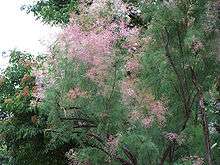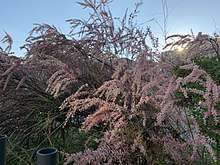Tamarix ramosissima
Tamarix ramosissima, commonly known as saltcedar[1] or salt cedar, is a deciduous arching shrub with reddish stems, feathery, pale green foliage, and characteristic small pink flowers.
| Tamarix ramosissima | |
|---|---|
 | |
| Scientific classification | |
| Kingdom: | Plantae |
| Clade: | Tracheophytes |
| Clade: | Angiosperms |
| Clade: | Eudicots |
| Order: | Caryophyllales |
| Family: | Tamaricaceae |
| Genus: | Tamarix |
| Species: | T. ramosissima |
| Binomial name | |
| Tamarix ramosissima | |
Description

Tamarix ramosissima is a hardy shrub or small tree native to Europe and Asia. It is a vigorous, deciduous shrub grown for its ornamental reddish stems, its showy plumes of flowers, and its unusual feathery leaves. Its hardiness and tolerance for poor soil make it a popular, easy to grow shrub. It can grow up to 8 m in height and up to 5 m in width. It can be used as a screen, windbreak, informal hedge or specimen shrub.[2]
It produces upright racemes of small, pink, five-petaled flowers from late summer to early autumn which cover the new wood of the plant. It is tolerant of many soil types, but prefers a well-drained, light or sandy soil in full sun. This plant is considered an invasive species in warmer climates.[2]
Invasive species
Tamarix ramosissima is a major invasive plant species in the Southwestern United States and Desert Region of California, consuming large amounts of groundwater in riparian and oases habitats.[2] The balance and strength of the native flora and fauna are being helped by various restoration projects, by removing tamarisk groves as if they were noxious weeds.[3]
Salt
The plant's common name refers to its ability to tolerate salt water[4] by excreting salt into its leaves through specialized salt glands — thereby producing salt deposits which kill other species;[5] these salt deposits can also weaken interatomic binding in soil clays, leading to increased erosion.[4]
| Wikimedia Commons has media related to Tamarix ramosissima. |
Further reading
- CISR - Saltcedar Center for Invasive Species Research summary on Saltcedar.
References
- "saltcedar". Invasive Plant Atlas. Retrieved April 24, 2019.
- Zouhar, Kris. 2003. Tamarix spp. In: Fire Effects Information System, [Online]. U.S. Department of Agriculture, Forest Service, Rocky Mountain Research Station, Fire Sciences Laboratory.
- Afton Canyon Riparian Restoration Project Fourth Year Status Report. Archived 2015-12-06 at the Wayback Machine Bureau of Land Management. accessed 6/20/2010
- Which came first, the salt or the saltcedar? A quantitative study of soil and groundwater chemistry along the Middle Rio Grande, New Mexico, by Michelle Cederborg, at the Colorado Riparian Association; published April 20, 2008; retrieved April 24, 2019
- Invasive Weeds - Salt Cedar, at the USDA Forest Service; retrieved April 24, 2019